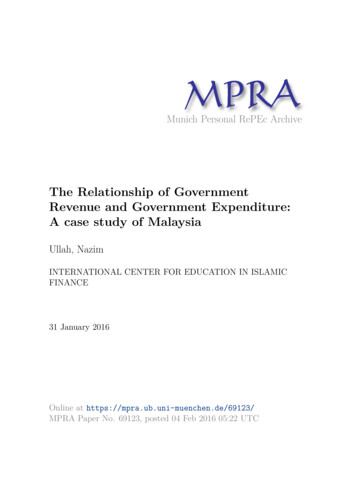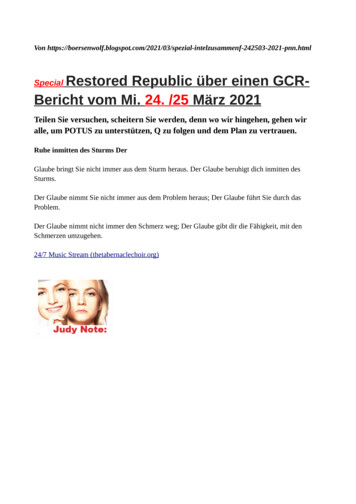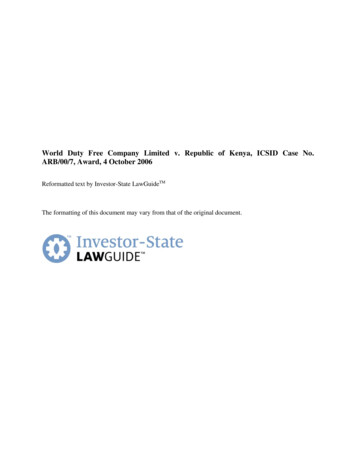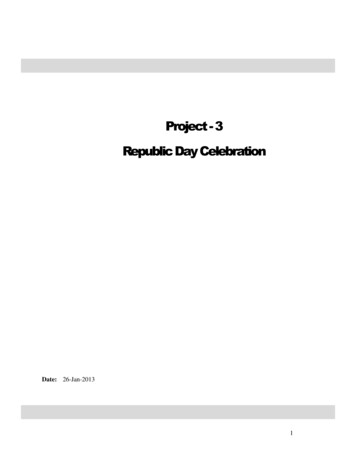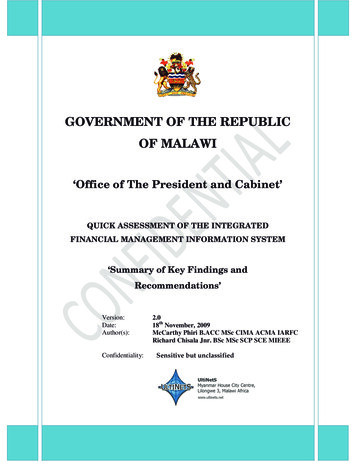
Transcription
GOVERNMENT OF THE REPUBLICOF MALAWI‘Office of The President and Cabinet’QUICK ASSESSMENT OF THE INTEGRATEDFINANCIAL MANAGEMENT INFORMATION SYSTEM‘Summary of Key Findings entiality:2.018th November, 2009McCarthy Phiri B.ACC MSc CIMA ACMA IARFCRichard Chisala Jnr. BSc MSc SCP SCE MIEEESensitive but unclassified
TABLE OF CONTENTS1.0 BACKGROUND . 31.1 Key objectives, scope and limitations of the assessment . 41.2 Overview on assessment methodology . 51.3 Summary of system implementation progress . 52.0 SUMMARY OF KEY FINDINGS, OBSERVATIONS &RECOMMENDATIONS. 72.1 Key achievements against IFMIS initial IFMIS objectives . 72.2 Key issues requiring attention . 82.3 Key recommendations and further assessment . 222.3.1 Recommendations . 222.3.2 Key areas requiring further review . 30ACRONYMS AND ABBREVIATIONS . 33Summary Report on the Assessment of GOM IFMIS Implementation (Quick Impacts Program) – UltiNetS 20092
1.0 BACKGROUNDThe Malawi Government through a Memorandum of Understanding withthe Government of Tanzania started implementing part of the Financialssuite of the EPICOR version 7.2 based IFMIS in November 2005. Thissystem was implemented by Soft-Tech Consultants Ltd, a Tanzanianbased authorized dealer of EPICOR1 ERP solutions in Africa. The systemis currently upgraded to version aniaimplementation model with no changes to the system base functionalityand reporting expect terminologies specific to the Malawi Governmentoperational context. The Malawi Government procured the followingmodules of the EPICOR Financials suite; General Ledger Accounts Payables Accounts Receivable Cash Management Commitments Planning and Control Electronic Funds Transfer Inventory Control Purchasing ReportingDespite Government paying for all key mentioned above modules of theupgraded EPICOR 7.2.3 Financials suite, the MoF through AGD iscurrently using only four which include; General Ledger, AccountsPayable, Purchasing and Cash Management from the Core accounting,and Active Planner (Budget module) mainly for budget formulation and1For more information on EPICOR solutions and services go to http:/www.epicor.comSummary Report on the Assessment of GOM IFMIS Implementation (Quick Impacts Program) – UltiNetS 20093
management processes. This module is used by the Budget division of theTreasury department within the ministry (MoF).As part of the continuous PFM reform processes in a bid to furtherenhance public expenditure management, the Malawi Governmentthrough the PSRMU of the OPC engaged the author through UltiNetS2 toundertake a quick impact assessment of the EPICOR based IFMISimplementation with a core objective to identify any system operational orfunctionality challenges and make appropriate recommendations gs,observationsandrecommendations for improvements and further review of the quickassessment of the Malawi Government EPICOR 7.2.3 based IFMISimplementation and impact.1.1 Key objectives, scope and limitations of the assessmentThe core objective of the assessment was to identify any system design,architectural and operational or functionality deficiencies and otherchallenges and make appropriate recommendations for improvements.This assessment was more limited to the EPICOR based IFMIS systemarchitecture, functionality, alert system, procurement, contractual andengagement process, project charter and implementation, system design,architectural and operational framework, system business processcontrols, system security posture, reporting capability, management,knowledge and capacity, project and change management, systeminterface capability, expectations, GWAN capability to support IFMIS andaudit and risk management capacity2UltiNeTS stands for Ultimate Internetworking Solutions, a local company specialized inproviding internet and networking services and products. For more information onservices and products of UltiNeTS go to http/:www.ultinets.netSummary Report on the Assessment of GOM IFMIS Implementation (Quick Impacts Program) – UltiNetS 20094
This assessment was meant to provide a snap short of the EPICOR basedIFMIS implementation and functionality situation to identify any issuesrequiring urgent attention before system functional expansion drive andfurther comprehensive review. Due to limited timeframe and scope, thisassessment did not further extend to other key Government resourcemanagement systems meant to be part of the IFMIS architectural andoperational framework or outside the framework as secondary datarepository or sources for government financial and other transactions, interms of their functionality and interface compatibility and capability.These subsystems include HRMS and Payroll, Revenue Collection andManagement systems such as ASYCUDA used by MRA and those used byRoad Traffic Directorate, Immigration and Civil Aviation departments tomention a few.1.2 Overview on assessment methodologyThe Consultant mostly used qualitative technique for data collection thatinvolved one to one interviews and questionnaires in some cases. Thisapproach ensured that adequate and accurate data and information wasgathered to form a realistic basis of reporting. Four main approaches tothe assignment were employed that mainly included; preliminarymeetings with key stake holders, one to one interviews with keyparticipants, system diagnosis and questionnaires to selected participants.1.3 Summary of system implementation progressDespite all the challenges surrounding the IFMIS system functionality,architectural incompleteness and short of some key expected benefits, theoverall implementation of EPICOR based IFMIS has been quite aremarkable and impressive achievement for the Malawi Government,more particularly considering the timeframe of under five years againstthe minimum of seven years for implementing such complex systems inSummary Report on the Assessment of GOM IFMIS Implementation (Quick Impacts Program) – UltiNetS 20095
Government setting as per the World Bank/IMF assessment of 37 IFMISprojects in 2003.The EPICOR based IFMIS has been successfully implemented at 33 siteswith four functional modules, one more than initial plan which mainlyinclude MDAs within Capital Hill, part of City Centre and RegionalCentres (Blantyre, Zomba and Mzuzu). The current system offers anumber of modules as mentioned in above paragraphs and a reportingmodule with a set of standard basic reports which are currently used bythe AGD and the MDAs.As part of the processes for ensuring business continuity, the AGD hasalso implemented a DRS with high speed fibre optical link within a 10mileradius from the primary data centre at the AGD financed by the USAIDthrough MCC Country Threshold Plan.The introduction of EPICORbased IFMIS has seen the centralization and consolidation of theGovernment payments and treasury accounts’ management systemthereby giving the AGD more control which is major strength of thecurrent system.Currently the system is accessed and used by those MDAs on GWANtransport platform and VPN connectivity. The AGD has also implementedan exceptional decentralized payments management system with theMalawi Defence Force, Police and State Residences running own CPOsparallel to the main system for confidentiality purposes though notjustified during the review.Summary Report on the Assessment of GOM IFMIS Implementation (Quick Impacts Program) – UltiNetS 20096
2.0 SUMMARY OF KEY FINDINGS, OBSERVATIONS &RECOMMENDATIONS2.1 Key achievements against IFMIS initial IFMIS objectivesThis assessment revealed that despite the incompleteness of the systemand other operational challenges, the implementation of EPICOR basedIFMIS has yielded some tangible results considering the background ofpurely and wholly manual systems which among others include thefollowing; The successful implementation of the EPICOR based IFMISsignificantly contributed to the debt cancellation for Malawi as acountry under the HIPC initiative The implementation of EPICOR based IFMIS has to some extentassisted the Government in restoring some fiscal discipline throughpublic expenditure management particularly on transactions thatare primarily processed through the system. ernment in reducing domestic debt and arrears through thecentralization of Government banks accounts and paymentsmanagement processes. The introduction of EPICOR based IFMIS has significantly checkedthe proliferation of Government bank accounts by the MDAsthereby giving the AGD a better control.Summary Report on the Assessment of GOM IFMIS Implementation (Quick Impacts Program) – UltiNetS 20097
The introduction of the EPICOR based CPS has significantlyrestored the credibility of Government cheque payments to itscreditors. The implementation of a centralized payment system with anelectronic cheque printing facility which has significantly reducedthe amount of effort and time for processing payments and the riskof errors often arising from complete manual processes.2.2 Key issues requiring attentionThe assessment revealed a number of key issues requiring attention byGovernment that included the following. The EPICOR based IFMIS does not fully meet all key initial designand implementation objectives as highlighted on section 2.3 of themain report particularly for the following key reasons; IFMIS project did not have a legally binding contract in absence of asigned copy which raises questions about the entire contractual andengagement process. There is no trace of any documentation such minutes, performancereports, which raises questions about the entire IFMIS contractmanagement process. There is no evidence of the Steering Committee’s approval or projectdelivery acceptance sign off documentation as provided for in thecontract to support complete service delivery and the legitimacy ofall milestone based payments made to Soft-Tech Consultants for theentire IFMIS projectSummary Report on the Assessment of GOM IFMIS Implementation (Quick Impacts Program) – UltiNetS 20098
The conditions of contract were more in favour of the contractor(Soft-Tech Consultants) than the client (Malawi Government) whichclearly shows that the client did not have much input into thedocument before engagement. The contractor (Soft-Tech Consultants) did not fulfill theircontractual obligations in that the system was partially deliveredwith only four functional modules of the complete financials suitewhich Government fully paid for. There is no evidence to establish if the system requirements gapanalysis was indeed performed as provided for in the ProjectCharter and if Government consented to the findings andrecommendations leading to the customisation of the system beforeimplementation. There was no valid justification for the training to be conducted foralmost the whole year and at every site of implementation, henceproved too expensive for the Government considering similarimplementations. There is no evidence of documented criteria used for thecomposition of key IFMIS organisational and project support teamsprovided for in the Project Charter, let alone their practicalexistence. The IFMIS contractual costs are too high than anticipated(almostUD 1.7million) more particularly on the user licences,consultancy, training services and travel which account for almost91% of the total cost.Summary Report on the Assessment of GOM IFMIS Implementation (Quick Impacts Program) – UltiNetS 20099
There was non strategic procurement of bout 240 system concurrentuser licences for all 32 sites for all the modules when only a few ofthese licences are currently used. The EPICOR based IFMIS system onoutdatedsystemtechnicalspecifications and requirements that were initially used for CODAbased IFMIS in 1996 which were not a true reflection of mentation in 2005. The EPICOR based IFMIS architecture, design and operationalframework is incomplete to constitute an ideal Government IFMISsystem design and operational architecture as it still falls short ofother key elements and full functionality of the system. There is no evidence that Soft-Tech Consultants made any referenceto the system requirements gap analysis findings and if at all theanalysis was conducted in the entire system customisation processas clearly evident in the flaws and incompleteness of the systemarchitectural, operational and reporting framework. There is a great deal of system underutilization considering thenumber of procured modules and other key features within theexisting functional modules that are currently not functional. The system is incomplete in physical and operational coverage as ithas not yet been fully rolled out to other Government departmentsand certain types of transactions still processed out the system e.gPart 1 The system does not have any alert system to detect any fraudulentactivities or any deviations to normal operations within the systemSummary Report on the Assessment of GOM IFMIS Implementation (Quick Impacts Program) – UltiNetS 200910
such as overriding system controls without appropriate approvalprocess and any system performance issues let alone a functionalaudit trail to track system usage The Project Charter is not authentic to be used as an officialdocument as it was not signed by both Government and Soft-TechConsultants hence this review questions the legitimacy and legalityof the entire project implementation process since it does not bindeither party in the agreement. The Project Charter is quite clear in terms of structure and contentas it meets most of the minimum expected requirements, however itdoes not clearly outline high level project risks and assumptionsand how they were to be mitigated. The Project Charter did not clearly define and incorporate anindependent system delivery quality assurance mechanism interms of the roles and expertise within the Financial Systems,Budget Systems and Technical Systems groups of the ProjectManagement Structure. The Project Charter does not clearly define the nature and scope ofpost implementation support particularly system maintenance andgeneral user support which has resulted in the Soft-TechConsultants being called on regular basis to provide even minorsupport that should ideally have be a responsibility of the coresupport team. The Project Charter did not clearly define the system transitionaland handover process to ensure adequate capacity was built withinthe core support team of the AGD for proper ownership of thesystem after implementation. This is also clearly evident in theSummary Report on the Assessment of GOM IFMIS Implementation (Quick Impacts Program) – UltiNetS 200911
frequency of both remote and on site support by Soft-TechConsultants which is costly for the Government. The EPICOR based IFMIS does not have any electronic interfacewith key sub systems meant to be part of the entire IFMISframework expect for the budget module which has been recentlyimplemented, hence difficult to provide Government with instantand timely financial data and information which was one of the keyobjectives of IFMIS as transactions from these systems are capturedmanually and historically e.g. revenue and other transactions fromMRA and Local Assemblies. The General Ledger setup does not have a comprehensive andpractical data quality assurance mechanism in terms of validationand regular integrity checks despite that the system does providesthat functionality. The General Ledger journal entry facility is not yet being used byAGD as well as MDAs for capturing all historical transactionsdespite the fact that the system provides for such. The current IFMIS CHART OF ACCOUNTS structure is based on acash basis of accounting as opposed to IPSAS cash modified asrecommended by the IPSAB which does not comprehensively coverall Government operations as some elements that among otherincludes, debt service commitments, pensions, fixed assets whichform significant part of the Government transactions are notrecorded and reported. The current Chart of Accounts does not have a comprehensivemulti-dimensional classification structure to adequately provide forvarying and multiple reporting needs across Government.Summary Report on the Assessment of GOM IFMIS Implementation (Quick Impacts Program) – UltiNetS 200912
The current Chart of Accounts is not yet fully GFS compliant as perthe IMF requirement and does not fully respond to the performancemeasurement indicators of the current MGDS. The current Budget module (Active Planner) does not ithintheGovernment. For instance it does not provide for automated budgetconsolidation process and tracking of budget revisions amongothers. From a budget execution perspective, the EPICOR based IFMISsystem is working perfectly as a budget expenditure control systemsince no funding or expenditure can take place where there is nobudget unless overridden, however the system does not blockbudgets that have already been expended to the equivalent ofexpenditures. The budgeting module (Active planner) has not net been rolled outto the MDAs even those that are currently on line and budgets arecompiled manually by the budget institutions and submitted to theTreasury for consolidation and uploading into the system. The IFMIS infrastructure does not have any intrusion preventionand detective system or mechanism to easily gain visibility andmonitor any potential security threats considering that the accessin mainly by user ID and password which can easily be accessed Although the AGD has implemented a DRS to ensure businesscontinuity which is quite a commendable development, there are nodocumented procedures spelling out the process of change over inSummary Report on the Assessment of GOM IFMIS Implementation (Quick Impacts Program) – UltiNetS 200913
the event of a crisis to ensure business continuity and even day today management of the site. The security of data in backup tapes is still at great risk as they arenot encrypted when transferring offsite from the main data centreat the AGD and secondary remote sites such as Police, MalawiDefence Force and State Residences. The security status of GWAN infrastructure still pose a greatsecurity challenge to all key Government resource managementsystems including EPICOR based IFMIS. Some of key control features particularly in the paymentmanagement approval process within the IFMIS are not yetactivated and functional to improve the entire system internalcontrol framework. The current payments management system is weak and prone toexploitation or abuse by colluders as access into the system yauthenticated beyond normal user ID and passwords due to lack ofappropriate tools. The EPICOR based IFMIS cash book is not electronically linked tothe RBM’s MIDAS payments/banking system to easily generalelectronic bank statements to facilitate instant bank reconciliationsand instant bank balance reporting. The current core accounting system and financials suite of theEPICOR based IFMIS has an Electronic
upgraded EPICOR 7.2.3 Financials suite, the MoF through AGD is currently using only four which include; General Ledger, Accounts Payable, Purchasing and Cash Management from the Core accounting, and Active

